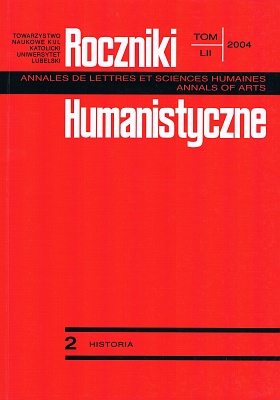Z dziejów Akcji Katolickiej
Abstrakt
The idea of establishing the Catholic Action emerged from the Catholic movements in Western Europe at the break of the 18th century. Its aim was to unite the Catholics divided by their political views into one higher ideal of the true social good, according to the principle saying that even if politics divides us, religion unites us.
In the period between the two World Wars basically two models of the Action were formed: the Italian one, stressing the state organization (there were four states: men, women, male youths and female youths), that was developed in Italy, the Netherlands, Poland, Spain and Latin America, and the French-Belgian one, assembling lay Catholics according to their social origin (the country, the city, the school, the university).
In that period in Poland two stages should be noted in the development of the Catholic Action: the initial one, when the Polish League (Liga Polska) was formed from the existing organizations and associations, and the second one, that is formal establishing of the Catholic Action, according to the Italian model.
The Catholic Action was organized according to various rules and it was formed in two different types: the Poznań one (it was supposed to influence the society currently and it aimed at making the social base of the Church broader), and the Warsaw one (that was rather oriented towards apostolate of the lay people). The Catholic League assembled Catholic elites coming from the circles of the clergy, gentry, industrialists, and to a small degree, from the worker class.
The turning point in the history of the Catholic League came with the creation of the Catholic Action by the Episcopacy Conference on 28-30 April 1930. St. Adalbert was chosen as the patron saint for the Action, and the feast of Christ the King was appointed as the patron feast. In the years 1930-32 the ordinaries of particular dioceses started establishing Diocesan Institutes for the Catholic Action. From 1931 an official paper appeared of the Catholic Action, Ruch Katolicki (Catholic Movement).
The Polish Catholic Action was rather complicated and well-developed. On the one hand it consisted of Institutes, and on the other, of Associations. It was a highly centralized organization, but at the same time its superior authorities included in its structure already existing organizations that had its own traditions. This led to certain tensions.
Despite its many shortcomings the Catholic Action undoubtedly exerted a great influence on spiritual, intellectual, cultural and social formation of the Catholics of the period. It is not strange then, that along with establishing III Polish Republic the thought appeared of resuming the work of the Catholic Action. Pope John Paul II in the adhortation Christofideles laici he issued in 1994, postulated a new form of its organization and work.
In 1996 all over Poland diocesan Institutes and parish Sections of the Catholic Action started being established – albeit with varying intensity. Election of the national authorities that took place in Częstochowa during the meeting of the delegates of diocesan Institutes on 21-22 November 1998, the eve of the patron feast of Christ the King of the Universe, was the crowning of the undertaken activities. The Polish Primate, Cardinal Józef Glemp, designated Mrs. Halina Szydełko from the Rzeszów Diocese for the post of the president, and he appointed Bishop Piotr Jarecki the Polish Church Assistant for the Catholic Action. It is under his pastoral protection that the Action has been developing since the moment it was reactivated.
Copyright (c) 2004 Roczniki Humanistyczne

Utwór dostępny jest na licencji Creative Commons Uznanie autorstwa – Użycie niekomercyjne – Bez utworów zależnych 4.0 Międzynarodowe.





